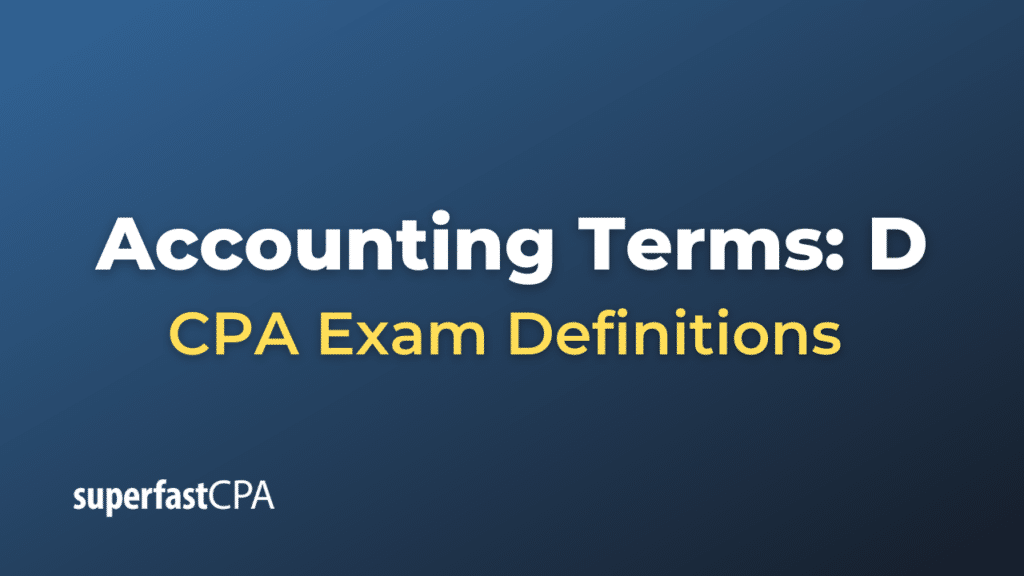Accounting Terms: D
Deductible Temporary Difference
Deferred Compensation Accounting
Deferred Tax Asset Valuation Allowance
Deficiency in Internal Control
Depreciation, Depletion, and Amortization
Depreciation of Leasehold Improvements
Determinants of Working Capital
Difference Between Accountants and Bookkeepers
Difference Between Accounting and Bookkeeping
Difference Between Accounts Receivable and Payable
Difference Between Accruals and Deferrals
Difference Between Actual Overhead and Applied Overhead
Difference Between Adjusting Entries and Closing Entries
Difference Between Adjusting Entries and Correcting Entries
Difference Between Amortization and Depreciation
Difference Between Assets and Fixed Assets
Difference Between Assets and Liabilities
Difference Between an Audit, Review, and Compilation
Difference Between Authorized Shares and Outstanding Shares
Difference Between Bad Debt and Doubtful Debt
Difference Between a Balance Sheet and an Income Statement
Difference Between Bank Balance and Book Balance
Difference Between Book Value and Market Value
Difference Between a Budget and a Forecast
Difference Between Business Risk and Financial Risk
Difference Between Capital Expenditure and Revenue Expenditure
Difference Between Cash Flow and Free Cash Flow
Difference Between Cash Flow and Funds Flow
Difference Between a CEO and a CFO
Difference Between a Consignor and a Consignee
Difference Between a Contractor and an Employee
Difference Between Contribution and Gross Margin
Difference Between Cost Accounting and Financial Accounting
Difference Between Cost and Expense
Difference Between Cost and Price
Difference Between a Cost Center and a Profit Center
Difference Between the Current Ratio and the Quick Ratio
Difference Between a Debtor and a Creditor
Difference Between Depreciation Expense and Accumulated Depreciation
Difference Between Depreciation on the Income Statement and Balance Sheet
Difference Between Direct and Indirect Cash Flow Methods
Difference Between Direct Costs and Indirect Costs
Difference Between Direct Labor and Indirect Labor
Difference Between Earnings and Profit
Difference Between EBIT and EBITDA
Difference Between Equity Financing and Debt Financing
Difference Between an Expense and an Expenditure
Difference Between Expenses and Losses
Difference Between Expenses and Payments
Difference Between Expensing and Capitalizing
Difference Between a Finance Lease and an Operating Lease
Difference Between Financial and Managerial Accounting
Difference Between Fixed Cost and Variable Cost
Difference Between Forward P/E and Trailing P/E
Difference Between GAAP and IFRS
Difference Between a General Ledger and a General Journal
Difference Between a General Ledger and a Trial Balance
Difference Between Gross Income and Net Income
Difference Between Gross Cost and Net Cost
Difference Between Gross Margin and Net Margin
Difference Between Gross Sales and Net Sales
Difference Between Implicit Costs and Explicit Costs
Difference Between Income and Profit
Difference Between Interest Expense and Interest Payable
Difference Between Internal and External Audits
Difference Between an Invoice and a Statement
Difference Between a Journal and a Ledger
Difference Between a Liability and a Debt
Difference Between Margin and Markup
Difference Between Marginal Costing and Absorption Costing
Difference Between Net Income and Net Cash Flow
Difference Between Nominal Accounts and Real Accounts
Difference Between Normal Costing and Standard Costing
Difference Between NPV and IRR
Difference Between Paid-in Capital and Retained Earnings
Difference Between Par Value and No Par Value Stock
Difference Between Periodic and Perpetual Inventory Systems
Difference Between Preferred Stock and Common Stock
Difference Between Present Value and Net Present Value
Difference Between Prime Costs and Conversion Costs
Difference Between Product Costs and Period Costs
Difference Between Profit and Cash Flow
Difference Between Public Accounting and Private Accounting
Difference Between Recourse Debt and Non-recourse Debt
Difference Between Reserves and Allowances
Difference Between Reserves and Provisions
Difference Between Revenues and Earnings
Difference Between Revenues and Receipts
Difference Between Salary and Wages
Difference Between Semimonthly and Biweekly Payroll
Difference Between a Shareholder and a Stakeholder
Difference Between Simple Interest and Compound Interest
Difference Between SOC Type 1 and Type 2 Reports
Difference Between a Stockholder and a Shareholder
Difference Between Stocks and Bonds
Difference Between Trade Date Accounting and Settlement Date Accounting
Difference Between a Trial Balance and a Balance Sheet
Difference Between Turnover and Profit
Difference Between an Unadjusted Trial Balance and an Adjusted Trial Balance
Difference Between Unearned Revenue and Unrecorded Revenue
Difference Between Vertical Analysis and Horizontal Analysis
Difference Between Work in Process and Work in Progress
Different Types of Accountants
Direct Material Price Variance
Direct Material Usage Variance
Direct Write-off Method vs Allowance Method
Discount Allowed and Discount Received
Does a Dividend Reduce Profit?
Does an Expense Appear on the Balance Sheet?













